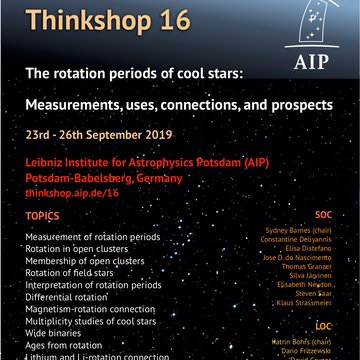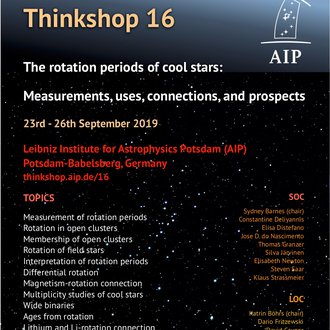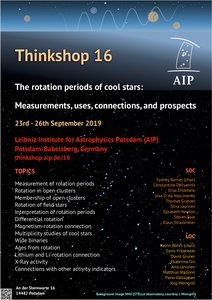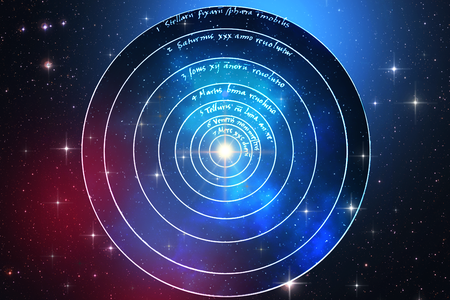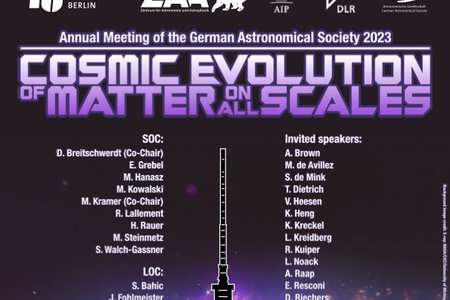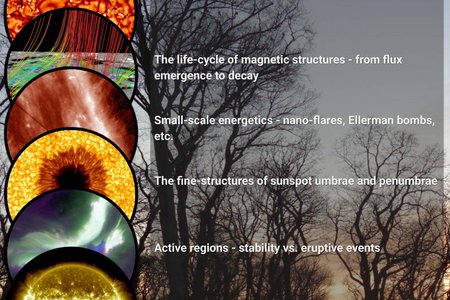16th Potsdam Thinkshop: The rotation periods of cool stars
From the 23rd to the 26th of September, more than 50 scientists meet at the 16th Potsdam Thinkshop on AIP’s campus in Babelsberg, Potsdam, Germany. Each year, the event series of the Leibniz Institute for Astrophysics Potsdam (AIP) focuses on a different field of astrophysical research. This year, the topic is the rotation of stars, the study of which provides new insights into their behavior beyond the classical measures of distance and brightness.
Sydney Barnes, leader of the stellar activity group at AIP and organizer of the conference, states: “This rotation seems to be the fundamental variable underlying many dynamical behaviors of stars such as the magnetic activity manifested in stellar dynamos, starspots, and solar or stellar flares. One application of measured stellar rotation rates is to derive the ages of stars, otherwise difficult to obtain.” These ages are helping to construct astronomical chronologies, that is, the dating of astronomical phenomena. Silva Järvinen, AIP-scientist in the stellar physics and exoplanets section, adds: “The AIP has played a leading role over the past decades in efforts to understand these magnetic phenomena for a large variety of stars, and also to measure related manifestations such as starspots, stellar magnetic fields, and rotation itself.” The rotation rates of increasingly large numbers of stars can now be measured precisely using telescopes on earth and also in space.
This conference will bring together an international cross-section of major contributors to the field to discuss the latest findings, and to put them in perspective.
Further information
From the 23rd to the 26th of September, more than 50 scientists meet at the 16th Potsdam Thinkshop on AIP’s campus in Babelsberg, Potsdam, Germany. Each year, the event series of the Leibniz Institute for Astrophysics Potsdam (AIP) focuses on a different field of astrophysical research. This year, the topic is the rotation of stars, the study of which provides new insights into their behavior beyond the classical measures of distance and brightness.
Sydney Barnes, leader of the stellar activity group at AIP and organizer of the conference, states: “This rotation seems to be the fundamental variable underlying many dynamical behaviors of stars such as the magnetic activity manifested in stellar dynamos, starspots, and solar or stellar flares. One application of measured stellar rotation rates is to derive the ages of stars, otherwise difficult to obtain.” These ages are helping to construct astronomical chronologies, that is, the dating of astronomical phenomena. Silva Järvinen, AIP-scientist in the stellar physics and exoplanets section, adds: “The AIP has played a leading role over the past decades in efforts to understand these magnetic phenomena for a large variety of stars, and also to measure related manifestations such as starspots, stellar magnetic fields, and rotation itself.” The rotation rates of increasingly large numbers of stars can now be measured precisely using telescopes on earth and also in space.
This conference will bring together an international cross-section of major contributors to the field to discuss the latest findings, and to put them in perspective.
Further information
Images
Poster for the Thinkshop.
Big screen size [1000 x 1412, 230 KB]
Original size [1122 x 1585, 280 KB]
